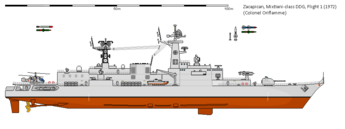Mixtiani-class destroyer
 ACZ Ixxotia
| |
| Class overview | |
|---|---|
| Name: | Mixtiani-class destroyer |
| Builders: | Acalliquetzcan Ecatzacuili |
| Operators: |
|
| Cost: | Undisclosed |
| In service: | 1972-Present |
| Planned: | 10 |
| Completed: | 8 |
| Cancelled: | 2 |
| Active: | 6 |
| General characteristics | |
| Class and type: | Guided-missile destroyer |
| Displacement: | 5,700 tons |
| Length: | 143.0 meters |
| Beam: | 14.1 meters |
| Draft: | 5.2 meters |
| Propulsion: |
list error: <br /> list (help) 2-shaft COGAG ∟2x Tlahqia 1036 gas turbine engines providing 40,000 shp (boost) ∟ 2x Tlahqia 860 gas turbine engines providing 10,000 shp (cruise) |
| Speed: |
list error: <br /> list (help) 34 knots maximum speed 16 knots cruising speed |
| Range: | 5,400 nautical miles (maximum range traveling at cruising speed) |
| Complement: | 352 |
| Sensors and processing systems: |
|
| Armament: |
|
| Aircraft carried: | 2x Itz-41 naval synchropter |
| Aviation facilities: | 1x aft aircraft hangar |
The Mixtiani-class destroyers are a class of guided-missile destroyers built for the Zacapine Navy as an intermediate vessel between the classification of escort ship exemplified by the Micomitl-class frigate and prime surface combatant embodied by the Nochcalima-class cruiser. In terms of armament and combat roles, the Mixtiani class is intended to function similarly to the nuclear-powered Nochcalima class at a smaller scale in terms of size, armament and cost, replacing the Nochcalima on missions in which the deployment of a cruiser would be considered an overcommitment of limited naval resources. Doctrine also prescribes the deployment of Mixtiani destroyers as an accompaniment to augment the combat potential of the Nochcalima-led battle force. This has earned the class the nickname "Teica ships" from the Nahuatl for "Little Sister". The class leader, the ACZ Ixxotia, was commissioned in 1972, while the last Mixtiani-class destroyed to be commissioned was the ACZ Itztica in 1989. Both vessels remain in active service today. Of the original 8 Mixtiani-class destroyers to be completed, 6 remain in service with the Zacapine Navy while the other two were transfered to the maritime contingent of the Zacapine National Guard and refitted for use as large patrol cutters.
Propulsion
Armament
The primary weapon of the Mixtiani-class is the Tlemitlaza Nohuiyanyo or "Universal Missile-launcher" system, a twin arm missile launcher fed from a magazine below deck with a capacity for up to 64 missiles. The system is capable of firing anti-air, anti-ship and anti-submarine missiles of multiple varieties as well as ground-attack cruise missiles designed for the launch platform. Each arm of the launcher can fire and reload missiles independently, with an individual rate of fire of as little as 8 seconds. The versatility of the arm launcher allows the Mixtiani class to be outfitted with a load of missiles suited to its particular mission, which can be replenished while underway in contrast to common VLS launchers. The firepower provided by the missile launcher is augmented by a TC-120 battery with twin 120mm canons, which is primarily intended to engage targets for which the use of a guided missile would be considered inadvisable, or else in the case that all suitable missiles have been expended in combat.
The self-defense capability of the Mixtiani class relies on four TCM-30 rotary canons, each fitted with six 30mm barrels. The array of TCM-30s is positioned to provide the maximum possible coverage with their firing arcs to fulfill their primary function as CIWS point-defense artillery. They are mostly intended to be used to destroy incoming missiles, but can also be employed against small craft and have been found to be critical in countering the emerging threat of USV attacks. It is additionally armed with two dedicated ITTA type anti-submarine rocket launchers, one deployed to each side of the ship, which were included as a secondary anti-submarine armament in the event that the primary magazine was depleted of anti-submarine missiles. Submarines could also be engaged by the Mixtiani's four 53 cm torpedo tubes, arranged in two pairs, which could launch electric homing torpedoes of both anti-submarine and anti-ship varieties.
The varied armament of the Mixtiani class earns in the designation of multirole destroyer. However, its intended role in Zacapine naval doctrine is to engage enemy combatants at range with its missile launcher, with the 120mm guns and 53 cm torpedo launchers being considered secondary armament.
In the two Mixtiani class destroyers that have been refitted for service with the National Guard, all weapons except the four TCM-30 rotary canons have been removed. The rotary canons are retained for the purposes of engaging small vessels during anti-smuggling operations.
Aviation
The aircraft hangar of the Mixtiani class destroyer is designed to hold two Itz-41 synchropters that can be launched and recovered via the helipad aft of the hangar. These Itz-41s serve the dual purposes of reconaissance and spotting aircraft for detection of enemy vessels and guidance of long range missile strikes to target, as well as general purpose anti-submarine helicopters that can be used to detect enemy submarines and, if necessary, engage them independently using depth charges. In the semi-civilianized National Guard refits of the Mixtiani class, a variant of the same Itz-41 synchropters are used for maritime patrol and search-and-rescue purposes.